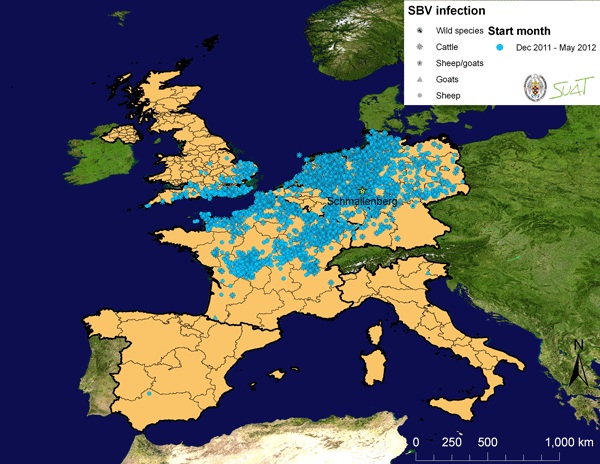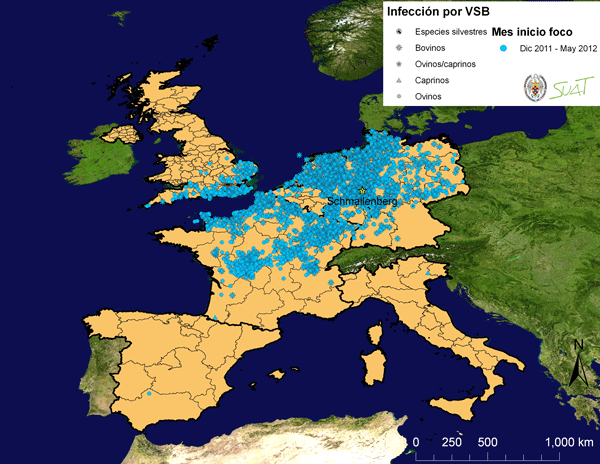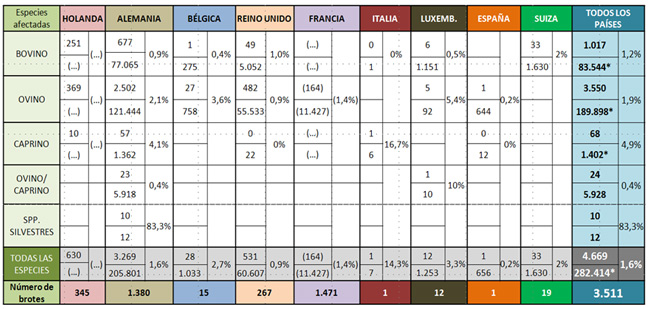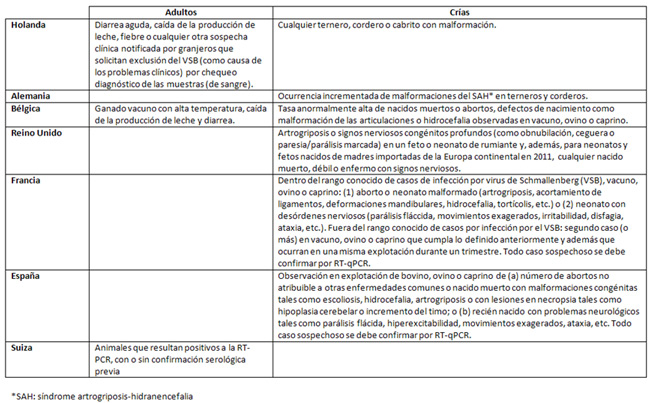Schmallenberg Virus
The emergence of a new previously unknown virus has created an international sanitary alert, especially in the European context. This virus, called "virus Schmallenberg", classified as a negative single-stranded RNA virus, belongs to the family Bunyaviridae and is responsible for causing primarily a reproductive disease in ruminants in northern Europe.
In the first epidemic wave (from December 2011 to May 2012) SBV affected eight countries of the European Union. On March 12th, 2012, Spain notified the first outbreak of Schmallenberg disease in a sheep farm in Córdoba (Andalusia). Up to date, infection has been confirmed in more than 4,600 ruminants, with a morbidity rate less than 2%.

The second epidemic wave has become evident in the last months, since several countries are notifying the birth of the typical malformed fetuses (see below) and the mild disease in adult cows. This suggests that SBV has the ability of overwintering in the affected countries. In addition, the virus was found in animals in Switzerland and Denmark.
Clinical findings are characterized by the appearance of fetuses with congenital malformations such as arthrogryposis, torticollis or brain hypoplasia, passing virtually unnoticed in adults. Transmission, like many bunyaviruses, is carried out by midges of the genus Culicoides, the same vectors that transmit the famous bluetongue virus. In fact, the region where outbreaks have originated and their geographical extent resemble the outbreaks of bluetongue serotype 8, occurred in the same countries since August 2006. However, the speed and spread area of SBV infection are much higher, suggesting that there may be several ways of transmission other than Culicoides spp.
Multiple antibody-based diagnostic techniques are designed. In fact, a vaccine against the virus is being developed, since infected animals show significant rates of neutralizing antibodies, encouraging data for the control of infection. Through metagenomics, a newly introduced diagnostic technique, the sequence of viral isolates has been identified. This pathogen is related to with other Orthobunyavirusmembers of the Simbu serogroup circulating in Asia, Oceania, America and Africa.
Although further epidemiological investigations are needed, this virus may alledgely be a variant of any of these Orthobunyavirus circulating in Africa, though recent studies point that SBV may be more ancient than expected. How it entered northern Europe is unknown. In fact, there are many uncertainties about the extent of this infection: how many animals will be affected, how long cases will continue to appear and how far the infection will spread. The long clinical silence (since an infected midge bites a pregnant female and the moment of parturition when congenital malformations are observed) hampers the notification of new cases of infection.
Therefore, and due to the first outbreak reported in Cordoba, Spanish Ministry of Agriculture, Food and Environment (MAGRAMA) will promote surveillance and control measures to address the potential infection.
However, given the low number of affected animals despite the rapid spread through Europe, health authorities of the European Union together with the OIE have decided not to include this disease in the list of notifiable diseases. This does not mean that the affected countries stop considering surveillance and control measures, since information about this new disease may serve to address the potential infection.
Epidemiological update
Map of western Europe which shows the location of the 3,511 foci compatible with Schmallenberg virus infection (SBV) that have been notified to the OIE. The star shows the location of the Schmallenberg city where the first positive samples were sent. The circles denote the outbreaks in sheep; the triangles mark the outbreaks in goats; the blades designated outbreaks in cattle; the pentagons represent the undefined foci for sheep or goats; the circles containing a deer indicate the outbreaks in wild animals. Figures in blue denote the foci from December 2011 to May 2012; red is used for the outbreaks from July-August 2012. The yellow star represents the city of Schmallenberg (Source: self-elaboration from data of the OIE-WAHID database until August 14th, 2012).

Summary data from the 3,511 reported outbreaks in northern Europe between December 14th, 2011 and August 13th, 2012. In every box of "species-country", the total number of cases, the total number of susceptible animals and the percentage of apparent morbidity are shown. The sum of susceptible animals (*) does not include the Netherlands, since this country does not report these data. Therefore, the overall apparent morbidity values are slightly increased. (Source: self-elaboration from data of the OIE-WAHID database until August 14th, 2012). The following table shows the different case definitions according to each country (Source: Technical Report of EFSA '"Schmallenberg" virus: Epidemiological likely scenarios and data Needs'; for the definition in Spain, extracted and translated from the “National Programme for Epidemiological Surveillance against Schmallenberg Virus, year 2012 [in Spanish]”).




